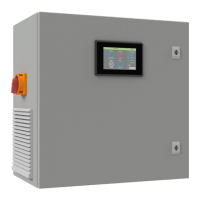8
P: 1800 281 282 | F: 1300 281 282 | E: info@matelecaustralia.com.au | W: www.matelecaustralia.com.au
Step 5 - Setup (Continued)
5.12 - Additional information for setting the No Demand Speed
The PID algorithm is used to control the speed of the pumps in the pressure VSD configuration to maintain a stable setpoint. Generally
larger pumps will need to have a slower PID response to smaller pumps. Care must be taken adjusting these values as they can
cause the system to become unstable. Also if the VSD acceleration and deceleration times are too large these delays can cause the
system pressure to oscillate. It is best to keep the VSD acceleration and deceleration as quick as possible without causing drive high
DC bus faults. Below are some tips to setting the PID:
• Proportional - Increasing the proportional will increase the speed of the PID causing quicker response accelerating and
decelerating. Too fast or too slow can cause system pressure over shoot. Set between 0.5(slow) and 2(fast).
• Integral - Increasing the integral will smooth out the PID when close to the setpoint. This increases the time to get to stable set
point if flow is not changing. Set between 1 (fast/unstable) to 50 (slow/stable).
• Derivative - Derivative should be left at 1 and not be changed.
Note - PID responsiveness changes based on the analog range. Increasing the analog range will slow down the PID. For example, at
1000kPa with P = 1 and I = 10 would be similar to 1600kPa with P=1 and I = 3.
5.11 - Additional information for setting the PID
The No demand speed is a critical parameter for the proper operation of the pressure VSD configuration, particularly for the correct
operation of the sleep and destaging functions. The no demand is to be set at the speed (Hz) at which one pump achieves the
setpoint against a dead head (shut discharge valve). If the system is operating as a mains boosting system with fluctuating mains
pressure it is best to set the no demand speed for the highest incoming mains pressure.
Follow these steps to find the no demand speed:
• Enter the required operating setpoint in the setup.
• On the main screen, place the system into auto mode.
• Open the main valve/tap of the system slightly. One pump should start.
• While the pump is running, slowly close the main discharge valve until it is just leaking a little water. The VSD should slow down to
a stable speed holding pressure at the required setpoint.
• Read the pump speed on the main screen. The no demand speed should be set 0.5Hz above this speed in the setup.
• If the speed is 25Hz the test failed, run the test again. This time try reopening the valve then closing with a slightly larger leak.
Alternatively, if there is no main discharge valve and no water is being used, follow these steps:
• Enter the required setpoint in the setup.
• On the main screen, place the system into manual mode.
• Ensure that the system pressure is less than the required setpoint.
• Put one pump into manual at an initial speed of 25Hz. The manual speed can be adjusted by touching on the speed on the
main screen. The system must be in manual mode to do this.
• Check if the pressure reading is at the required setpoint.
• If not, increase the manual speed in small steps until the system pressure is at the required setpoint.
• Once the setpoint is reached, read the pump speed on the main screen. The no demand speed should be set 0.5Hz above this
speed in the setup.
If the setpoint is changed then the no demand speed will need to be recalculated because it relates to the pump performance
at the system pressure.

